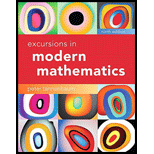
Concept explainers
This exercise comes in two parts. Read Part I and answer (a) and (b), then read Part II and answer (c) and (d).
Part I. The Intergalactic Federation consists of three sovereign planets: Aila, with a population of 5.2 million, Balin, with a population of 15.1 million, and Cona, with a population of 10.6 million. The Intergalactic Parliament has 50 seats that are apportioned among the three planets based on their populations.
a. Find the standard divisor in the Intergalactic Parliament.
b. Find the apportionment of the 50 seats to the three planets under Hamilton's method.
Part II. Based on the results of a referendum, the federation expands to include a fourth planet, Dent, with a population of 9.5 million. To account for the additional population the number of seats in the Intergalactic Parliament is increased by 15 to a total of 65. [9.5 million individuals represent approximately 15 seats based on the standard divisor foundin (a).]
c. Find the apportionment of the 65 seats to the four planets using Hamilton's method.
d. Which paradox is illustrated by the results of (b) and (c)? Explain.
Want to see the full answer?
Check out a sample textbook solution
Chapter 4 Solutions
Excursions in Modern Mathematics (9th Edition)
- Suppose that you have a normal population of quiz scores with mean 40 and standard deviation 10. Select a random sample of 40. What’s the chance that the mean of the quiz scores won’t exceed 45?Select one individual from the population. What’s the chance that his/her quiz score won’t exceed 45?arrow_forwardSuppose that you take a sample of 100 from a population that contains 45 percent Democrats. What sample size condition do you need to check here (if any)?What’s the standard error of ^P?Compare the standard errors of ^p n=100 for ,n=1000 , n=10,000, and comment.arrow_forwardSuppose that a class’s test scores have a mean of 80 and standard deviation of 5. You choose 25 students from the class. What’s the chance that the group’s average test score is more than 82?arrow_forward
- Suppose that you collect data on 10 products and check their weights. The average should be 10 ounces, but your sample mean is 9 ounces with standard deviation 2 ounces. Find the standard score.What percentile is the standard score found in part a of this question closest to?Suppose that the mean really is 10 ounces. Do you find these results unusual? Use probabilities to explain.arrow_forwardSuppose that you want to sample expensive computer chips, but you can have only n=3 of them. Should you continue the experiment?arrow_forwardSuppose that studies claim that 40 percent of cellphone owners use their phones in the car while driving. What’s the chance that more than 425 out of a random sample of 1,000 cellphone owners say they use their phones while driving?arrow_forward
- Suppose that the average length of stay in Europe for American tourists is 17 days, with standard deviation 4.5. You choose a random sample of 16 American tourists. The sample of 16 stay an average of 18.5 days or more. What’s the chance of that happening?arrow_forwardHow do you recognize that a statistical problem requires you to use the CLT? Think of one or two clues you can look for. (Assume quantitative data.)arrow_forwardSuppose that you take a sample of 100 from a skewed population with mean 50 and standard deviation 15. What sample size condition do you need to check here (if any)?What’s the shape and center of the sampling distribution for ?What’s the standard error?arrow_forward
- 1 5 1 2 3 1 6 7 -4 -3 -2 -1 0 1 2 3 -1 4 Which point is not included in the solution cot for the inequality? 5arrow_forwardWhich graph represents the solution of y > x2 + 2?arrow_forwardA boat's value over time, x, is given as the function f(x) = 400(b)x. Which graph shows the boat's value decreasing at a rate of 25% per year?arrow_forward
 Linear Algebra: A Modern IntroductionAlgebraISBN:9781285463247Author:David PoolePublisher:Cengage LearningAlgebra & Trigonometry with Analytic GeometryAlgebraISBN:9781133382119Author:SwokowskiPublisher:Cengage
Linear Algebra: A Modern IntroductionAlgebraISBN:9781285463247Author:David PoolePublisher:Cengage LearningAlgebra & Trigonometry with Analytic GeometryAlgebraISBN:9781133382119Author:SwokowskiPublisher:Cengage College AlgebraAlgebraISBN:9781305115545Author:James Stewart, Lothar Redlin, Saleem WatsonPublisher:Cengage Learning
College AlgebraAlgebraISBN:9781305115545Author:James Stewart, Lothar Redlin, Saleem WatsonPublisher:Cengage Learning Algebra and Trigonometry (MindTap Course List)AlgebraISBN:9781305071742Author:James Stewart, Lothar Redlin, Saleem WatsonPublisher:Cengage Learning
Algebra and Trigonometry (MindTap Course List)AlgebraISBN:9781305071742Author:James Stewart, Lothar Redlin, Saleem WatsonPublisher:Cengage Learning



